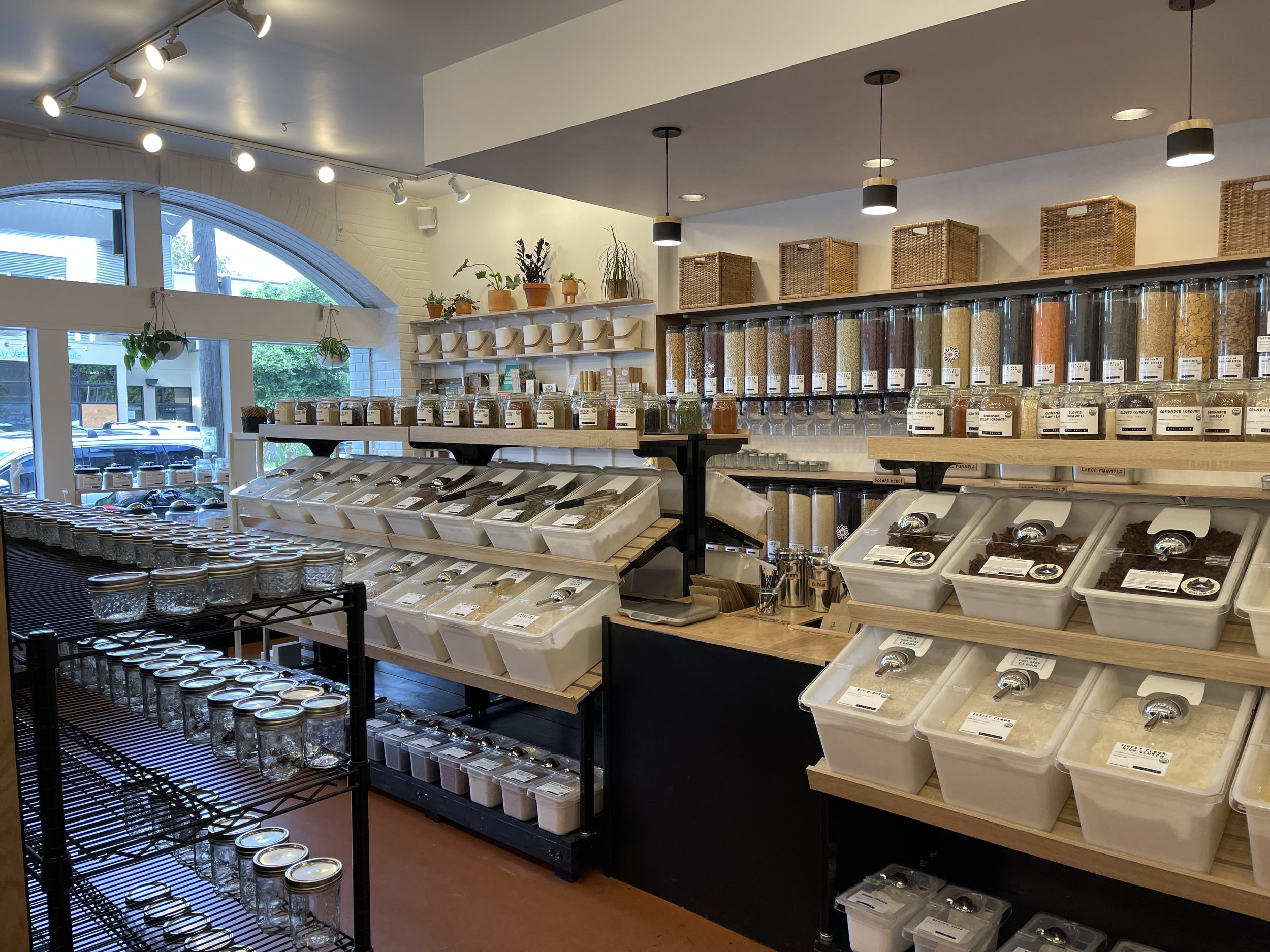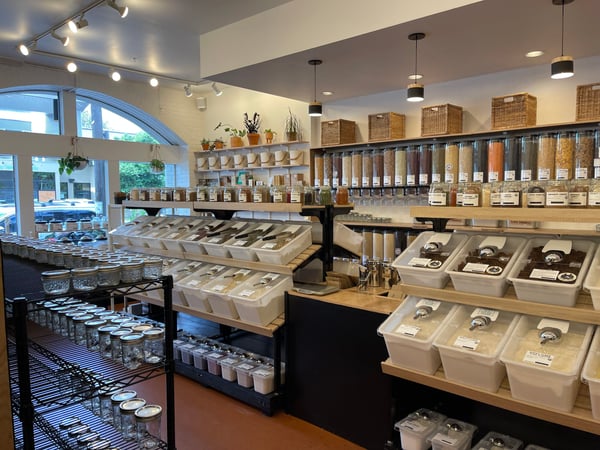
Many shoppers (and even some businesses) don’t realize that Oregon’s Health Code does not allow for consumer or store-owned reusable containers to be used in bulk sections or for produce. But, as the OR Dept. of Agriculture has started cracking down on some businesses that allow reusable containers, consumers and businesses alike started calling for a change. Senator Sollman, a fierce supporter of plastic reduction, co-hosted a webinar with Surfrider Foundation to hear from small businesses and Oregon leaders in waste reduction on opportunities and challenges establishing “legal” reuse systems and consumer opportunities for reusables under Oregon’s Health Code.
Currently, a subcommittee of Oregon Dept. of Agriculture’s Food Safety Advisory Committee is exploring rule changes to the state’s health code to better enable reusable containers. Surfrider Foundation and Senator Sollman both sit on the subcommittee; however few, if any, small businesses have had much of a seat at the table or opportunities to influence health code policy.
The purpose of the event, co-sponsored by Environment Oregon and Oceana, was to share information on the current process but also to gather feedback and hear important stakeholder interests from small businesses actively operating in the reuse and zero waste retail space. More than half of the webinar attendees currently bring their own containers to the bulk section at least half of the time even though more than half of the attendees also admitted to knowing bringing their own container is not allowed by Oregon’s Health Code.
The fact that businesses and consumers have been bringing their own for decades – without any issues in most cases – should mean something, right?
Oregon’s Health Code only allows refillable containers for beverages, under certain conditions, containers that are refilled in a regulated processing plant, or containers that are exchanged and sanitized offsite (like Rogue To Go, Benton To Go, and Bold Reuse [formerly GO Box]). The code does not allow consumer or business owned refillable containers or container exchanges operated by the store (unless the business gets special permission called a variance).
Other states are already allowing reusable containers. Washington allows most containers, but there are limitations depending on the food type. California only allows specific containers and most foods can be placed in reusable containers. Businesses in Washington and California complain that the requirements to prevent contamination are too onerous. Illinois has one of the most liberal reuse laws. They allow almost any container and no food types are disallowed. Illinois even made it illegal for individual counties to make it illegal to use refillable containers.
The Realm Refillery in Portland is the first zero packaging grocery store in Oregon. It took them 18 months to develop the variance with the Dept. of Agriculture that allows them to offer all of their products in bulk in refillable containers. The variance requires customers to use specific containers provided by the store. Those containers must be cleaned by the store before being used again. The Realm Refillery has experienced customer loss because they cannot allow customers to bring their own containers. Customers often complain that other stores (who have not had enforcement action from ODA) allow them to bring any container they want.
 The Realm Refillery in Portland
The Realm Refillery in Portland
Brit and Ryan, owners of The Realm Refillery, were inspired to create a zero packaging grocery store while traveling and observing package-free was the norm in many countries. They keep in touch with a national and international network of package free stores. The Source Bulk, based in Australia, was established in 2012 and they now have more than 60 stores in Australia with additional franchises in Canada, the UK, and New Zealand. All of the franchises allow customers to bring their own containers and they report there have been no issues caused by allowing customers to bring their own.
Brit and Ryan started a petition about updating Oregon’s health code to allow consumers to bring their own containers and in three months they have collected more than 2,000 signatures (sign the petition here!). They shared that a lot of the current laws are set for large chain retailers in mind as opposed to small stores like us. These large stores could choose not to allow customers to bring in their own containers but that shouldn’t stop small stores from allowing it.
John Burr, Program Manager for the Food Safety Program of the Oregon Department of Agriculture, reported that ODA first assembled a group of advocates and industry in 2019 to discuss reusable containers but that process was waylaid by COVID. That group reconvened in 2022 and is currently working on adapting the Washington code for Oregon, which would allow the refilling of some food in clean containers.
Abby Boudouris, Legislative Analyst for the Department of Environmental Quality, shared that the DEQ Materials Management Program works to reduce the environmental and health impacts of products and materials made and used in Oregon. They do that by promoting waste prevention and proper recovery and disposal of waste through the whole life cycle using the solid waste hierarchy with reuse being higher than recycling or disposal. Recycling and reuse are both important methods. Reuse typically is environmentally preferable. Reuse maintains that product in their original form whereas in contrast recycling requires destroying them and making them into new products.
The webinar ended with a Q&A session driven by audience questions.
How does it work with weighing bring your own containers? [Brit & Ryan] We have a system that knows the tare weight of the specific containers customers are allowed to use so we weigh filled containers at the register. Our system was built for customers to bring their own containers. Containers would be given a microchip that customers scan when they bring the container in to add the tare weight into the system. After that, they just scan filled containers and the system subtracts the tare weight. Charlie added there are some businesses selling refillable containers that have the tare weight printed on them.
In which ways if any does the reusable container work intersect with the recycling modernization act work? [Abby] They’re very parallel. Particularly there is funding from the Recycling Modernization Act that will come from producers in several years that will be offered via grants for specific projects. We need to have a holistic system for dealing with waste.
What is the timeline for the rulemaking process for updating the code with ODA and how can the public best get involved? [John] The public can sign up for Gov Delivery to get all of the blasts from the Dept. of Ag. (Sign up here [https://oda.fyi/subscribe]). The draft rules will be sent to the DoJ for review in the next week. Then the Advisory Committee will review the draft. Once approved, the rulemaking can begin and that can be as quick as a few months. So we are looking potentially at the end of the year.
For a zero waste store, how do you receive your goods? [Brit] We actually don’t call ourselves a zero waste store – we like low impact. Zero waste is a very hard thing to achieve for us living in such a linear economy. We have been doing a lot of work with that. Most of our items come in a closed loop – a five gallon bucket we wash and give back to the supplier. A lot of our bulk dry goods come in a paper sack. As retailers we can buy a large quantity that doesn’t involve any plastic.
How do restrictions in the US compare to those in Europe given they seem to be closer to moving towards circularity. [Brit & Ryan] The Source Bulk has more than 60 locations in Australia, the UK, Canada, and New Zealand. There’s a chain in Germany called the Original Unverpackt which was the first chain of low impact grocery stores in the world. None of these countries have any restrictions on customers bringing their own containers. It’s super normalized and actually encouraged and that’s what makes it so hard to live in the United States. Where other countries encourage it, we have to turn customers away on a daily basis.
How much is the plastic industry lobbying at the federal and state levels for airing on the side of caution with packaging? [Charlie] The federal code has been mostly influenced by large stores, retailers, producers, and otherwise. Packaging is marketing for them. [John] We haven’t received any comments or questions from them that I’m aware of.
It sounds like there’s support from ODA and DEQ for moving forward on this. What are the barriers and challenges that remain? Is it political? [John] I don’t know that it’s something political. We’re going to continue to listen to the needs of consumer advocates and we’ll write the rules as we’ve been talking about. There will be a process for people to comment on them. If we think we can make it work, we’ll put it into administrative rules. [Charlie] There are concerns from the large grocery stores on what the rules will require them to do. Right now, there’s nothing that would require them to do anything. Beyond that there are concerns about risk – what is the process for preventing contamination and what containers are allowed. [Sen. Sollman] It’s not political. The importance of this discussion is this is a consumer driven issue. Consumers are wanting to make sure and we’re getting a little bit clogged up in rulemaking and does there need to be a bill. There’s another large grocery store looking to do a pilot project because they've been hearing from their customers.
If you missed the event, watch the recording below:
